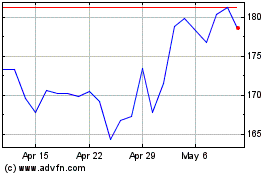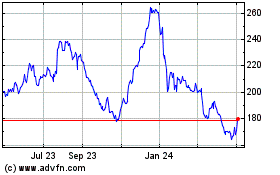Boeing to Consolidate 787 Dreamliner Production in South Carolina -- 2nd Update
October 01 2020 - 8:11PM
Dow Jones News
By Andrew Tangel
Boeing Co. said it is ending production of its 787 Dreamliner in
the Seattle area after more than a decade and plans to consolidate
assembly of the popular wide-body jet to its factory in South
Carolina next year.
The Chicago-based aerospace giant's decision Thursday follows a
sharp drop in demand for passenger jets as the coronavirus pandemic
has sapped demand for global air travel. Boeing had previously
slashed Dreamliner production and said in July it would study
consolidating production.
"I know this isn't easy, and I appreciate how we have supported
each other and stayed nimble while we look at every opportunity to
adapt, preserve our liquidity and be more competitive in a very
different commercial market," Stan Deal, Boeing's commercial
division chief, said in a memo to employees Thursday morning.
The announcement comes amid criticism from elected Washington
state officials, who vowed to lure back 787 production once the
aviation sector rebounds. The Wall Street Journal reported late
Tuesday that Boeing's decision to consolidate Dreamliner production
in North Charleston, S.C., was expected as soon as this week.
Washington Gov. Jay Inslee said Thursday that the state would
consider revoking more than $100 million in tax breaks Boeing
receives every year. He said Boeing had benefited from $2.2 billion
in state aid to develop the Dreamliner.
"It is not a one-way street, and we have to have the Boeing
company think in those terms," Mr. Inslee said at a press
conference late Thursday.
A Boeing spokesman said the company was entirely focused on
"managing the company through the biggest aerospace challenge in
history."
Boeing has been producing smaller 787-8 and -9 models in
Everett, Wash., near Seattle since 2007. In 2010, the plane maker
opened a second line in North Charleston, S.C. But only the South
Carolina plant is set up to produce Boeing's larger 787-10 model,
the plane maker said Thursday.
It wasn't immediately clear how relocating production for all
the 787 models to South Carolina would affect Boeing's heavily
unionized workforce in the Puget Sound region and the Seattle area
economy. About 1,000 workers produce the 787 in Everett, according
to a local spokeswoman for their union, the International
Association of Machinists and Aerospace Workers.
Jon Holden, president of IAM District 751, called the
consolidation "another in a string of bad decisions Boeing has
made."
Boeing said it was assessing potential fallout on its workforces
in both Everett and North Charleston. Efforts to unionize Boeing's
workforce in South Carolina, a right-to-work state, haven't
succeeded. Right-to-work laws allow workers in unionized workplaces
to opt out of paying union dues, effectively diminishing the power
of organized labor.
As part of its study, Boeing said it evaluated how a
consolidation would affect suppliers and customers. In the end, the
company said, the move will make producing the Dreamliner more
efficient and help it better target factory improvements.
Earlier this year, production problems at the South Carolina
plant prompted the Federal Aviation Administration to undertake a
broader review of quality-control lapses. The Boeing spokesman said
those problems didn't play a direct role in the consolidation
decision, but the company hopes the move will help it improve
quality controls.
Boeing said earlier this year it would slash production of
passenger jets and cut its workforce by about 10%. As the pandemic
worsened in the U.S. and air-travel demand remained depressed,
Boeing has said it was considering cuts beyond the 19,000 it had
already flagged.
Boeing employs more than 7,000 workers in North Charleston,
where it also has an engine-research facility. That compares with
almost 70,000 employees in Washington, including around 30,000 at
the Everett plant.
The Everett facility also produces wide-body 767s, 777s and
747s. It produced around 15 wide-body jets a month at its peak,
which would drop to around six and fall further with the 747
program set to end in 2022 and with output of the new 777X reduced
as Boeing delayed first deliveries until 2022.
Boeing's narrow-body 737 MAX, which has been grounded after two
fatal crashes, is produced at a separate Boeing factory in Renton,
Wash., south of Seattle. Mr. Deal said the consolidation didn't
change Boeing's commitment to Washington state.
After boosting Dreamliner production last year to 14 a month --
split evenly between Everett and South Carolina -- Boeing has
reduced output to 10 and plans to make six a month next year.
Boeing said Thursday it would continue making Dreamliners in
Everett until it cuts its production rate as planned in 2021.
Write to Andrew Tangel at Andrew.Tangel@wsj.com
(END) Dow Jones Newswires
October 01, 2020 19:56 ET (23:56 GMT)
Copyright (c) 2020 Dow Jones & Company, Inc.
Boeing (NYSE:BA)
Historical Stock Chart
From Jun 2024 to Jul 2024

Boeing (NYSE:BA)
Historical Stock Chart
From Jul 2023 to Jul 2024
